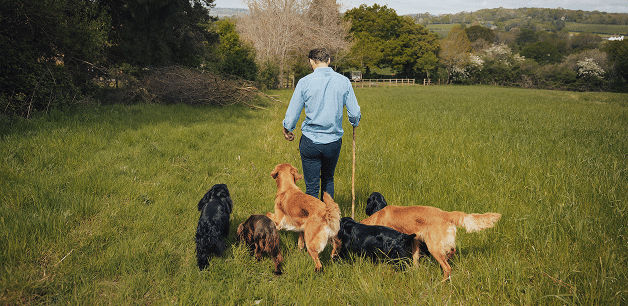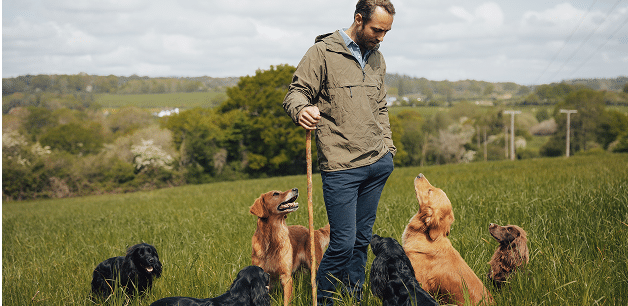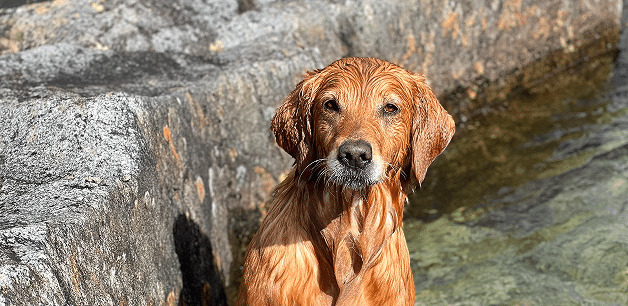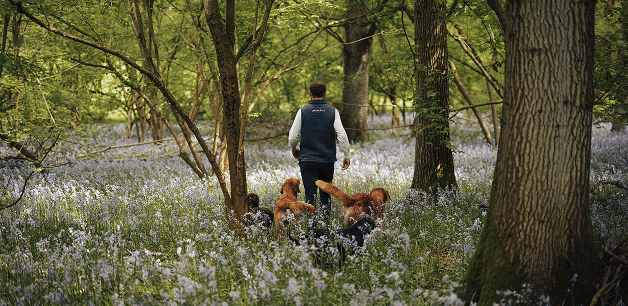Adventure is out there!
There’s something profoundly grounding about walking side by side with your dog in the wild. No phones, no distractions, just fresh air, the rustle of the leaves and the quiet companionship of your four-legged friend. For me, trekking with my dogs has always been more than just a hobby – it became a way to find calm and clarity when my mind felt clouded. During a time when I was struggling with clinical depression, hiking with Ella and the rest of my pack gave me a sense of purpose and routine that quietly helped me heal.
Whether it’s a short ramble or one of our longer hikes, those moments on the trail are where I feel most alive and connected to my dogs. If you’re wondering how to start hiking with your dog, or you’re curious about what to take hiking with a dog for the first time, you’re in the right place. This guide pulls from years of trail adventures with my own dogs, and I can’t wait to share them with you!

Why hike with your dog?
Dogs were born to move. Whether bounding through woodland or sniffing their way up a coastal path, there’s something truly special about the natural world. Trekking with your dog doesn’t just benefit them (and you) physically – it nurtures mental wellbeing, too. And let’s be honest, we could all use a little more nature in our lives.
That said, not all dogs – or routes – are the same. So before you hit the trail, there are a few things to consider.
Get to know your dog’s energy level
Every dog has a different energy level. My golden retrievers will happily plod for hours, tails wagging and noses to the ground, while my cocker spaniels dart in and out of the undergrowth like rockets. But these days, with Zulu well into his senior years, I’ve noticed he prefers shorter, gentler strolls – and that’s okay. It’s all about tuning in to what they need. Take into account your own dog’s age, breed and fitness. If they’re not used to long distances, start with gentle 1-2 hour hikes and build up gradually.
If your dog is still growing, or they’re a senior dog, take extra care. Long hikes over uneven terrain might not be the best idea until they’re fully developed, or might require a slower pace and more frequent rests. When in doubt, always check with your vet before making changes to your dog’s routine, especially if they have medical issues to consider.

Choosing a dog friendly hiking route
Before heading out, make sure the trail you’re considering is dog friendly. Some parks and nature reserves in the UK have restrictions to protect wildlife or livestock, so it’s worth researching ahead. Apps like AllTrails or local walking groups on Facebook can be a great resource for finding suitable routes.
Important: if you’re planning a longer hike or a wild camping trip, always check whether there’s access to fresh water along your route. Your dog will need to stay hydrated and ideally have somewhere to cool off with a paddle, especially during the warmer months. I also make a habit of noting down the nearest emergency vet when I’m heading off the beaten track, just in case.

What to take hiking with your dog
Packing properly can be the difference between a great day out and an emergency situation. Here’s my go-to checklist for hiking with dogs – tried and tested!
At least four litres of water (plus a collapsible bowl): For a full day out, pack two litres for you and two for your dog. Staying hydrated is essential, especially in warmer weather – so I always make a point of offering cool water at regular stops.
Dog first aid kit: Cuts, ticks, or sore paws can happen on hikes. Some main essentials are bandages, tweezers, antiseptic wipes and a tick remover. For more rigorous hikes, I also carry a lightweight dog sling – just in case of an injury like a sprain or a torn ACL, where I might need to carry one of mine back to the car.
Poo bags: Leave no trace – Consider a water soluble poo bag like Project Harmless – a truly eco-friendly option
Energy: When I’m hiking with my dogs, I make sure to bring both food and treats that are easy to carry and packed with nutrition. Our Freeze-Dried and Air-Dried treats are perfect for shorter trips. They’re lightweight, full of goodness, and great for giving your dog a quick energy boost when they need it most. For longer camping trips or multi-day adventures, I rely on our Freeze-Dried Raw food as it’s easy to pack, keeps well, and gives my dogs the sustained fuel they need to keep going.
Lead or long line: Even if your dog is well-behaved off-lead, you’ll need to keep them on a lead in livestock/wildlife areas or when passing others, especially if they have a dog on the lead.
Towel or drying mitt: For muddy paws, wet bellies and post-paddle clean-ups.
Jacket or boots (if needed): Not every dog needs them, but some breeds – especially in cold, wet, or rocky conditions, benefit from protective gear.
Identification tag and microchip: It’s not just sensible – it’s a legal requirement to have your dog microchipped. Make sure their ID tag is up to date too, so if they do get separated from you, they can be safely and quickly reunited.

Training your dog to be a great hiking companion
If your dog is new to hiking, start small. Build up their endurance gradually with regular walks on different surfaces and elevations. It’s also important to condition their paws slowly using a natural paw balm or organic coconut oil. Toughening them up over time helps prevent soreness and injuries on rougher trails. Reward good behaviour on the trail, and reinforce recall often, especially when distractions like wildlife or other dogs are around.
You might find that your dog becomes a “trail dog” in no time, settling into the rhythm of the hike and learning to watch your cues for rest stops, snacks, or photo opportunities!
One thing I’ve learned is that consistency builds confidence. The more your dog hikes with you, the better they’ll understand the flow of a walk in the wild, and the stronger your bond will become.
Listen to your dog
It’s easy to get caught up in the excitement of hiking, but remember, this is a shared journey. Keep an eye on your dog’s posture, panting and paws. Stop regularly for water and shade, and take time to let them sniff, explore and enjoy the trail in their own way.
If your dog starts limping, lagging, or seems uncomfortable, don’t push it, make sure to rest or call it a day if they need it – you can always try again another time. It’s better to be safe than sorry, in my book.

Ready to hit the trail?
To me, hiking with dogs is one of the purest joys in life. No matter how many mountains we climb or valleys we cross, it’s the feeling of walking in step with my dogs that brings me the most happiness.
So, pack your bag, clip on the lead, and set off on your own adventure. Whether it’s your first dog walk on a forest trail or your tenth multi-day trek through the Highlands, the memories you’ll create with your dog by your side are the ones that truly last.
Here’s to the start of The Great Outpaws – see you out there.
James x
